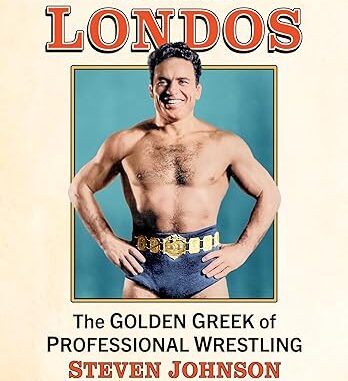
Review Fix chats with “Jim Londos: The Golden Greek of Professional Wrestling” author Steven Johnson, who discusses the creative process behind the book.
About Steven Johnson:
Steven Johnson is a veteran newspaper, magazine, and digital reporter and editor in Mechanicsville, Virginia. He has won multiple awards for in-depth reporting and is co-author of five previous books on the history of professional wrestling.
About Jim Londos: The Golden Greek of Professional Wrestling:
The most famous active athlete in the world during the Great Depression was not Babe Ruth, Sonja Henie or Babe Didrikson. It was a determined Greek immigrant who sailed across the Atlantic Ocean as a 15-year-old to escape a demanding father and start a life abroad. Jim Londos slept in railcars and firehouses to make ends meet and quickly found refuge on the mat.
Combining an Old World work ethic with a flair for the dramatic, Londos overcame skeptics and antagonists to become pro wrestling’s greatest star, an international celebrity who walked with presidents, prime ministers and the common man. He was responsible for keeping wrestling alive during the Depression and representing achievement to ethnic minorities, underdogs and women, all of whom he attracted in record numbers. This complete biography of Jim Londos tells the story of the first great immigrant athlete, a man who rescued the soiled sport of wrestling when it was down for the count, and brought hope and inspiration to his countrymen and millions worldwide.
Review Fix: How did you get interested in Jim?
Steven Johnson: John Capouya wrote a great book on Gorgeous George a few years ago, positioning George as sort of the prototype “look at me” boy of postwar sports, a la Dennis Rodman or Floyd Mayweather, for example. But George’s story did not end well; he rocketed to fame but plummeted rather quickly, battled alcoholism and died at an early age.
Londos was kind of the anti-George. He was a bit of a showman, of course, but never to excess; any theatrics he had were within the confine and storytelling of the match. His career lasted an amazing 45 years, always reliable, always steadfast in his demeanor and presentation. More than anyone of his day, he was “wrestler to the world.” But history has kind of glossed over him because of the somewhat mixed opinion of his profession and the fact that he preceded the TV era in which George was so prominent.
Review Fix: How familiar were you with his work before you started the book?
Johnson: I’ve been following wrestling since I was a kid, so I knew the name and the general notion that he was an important figure in the sport. Wrestling magazines of the 1970s would occasionally do a “where are they now” feature on him, or noted his death in 1975. There are some Londos videos on YouTube. So I had an idea of what he did, but that’s different from telling who he was, which is the focus of the book.
Review Fix: What was the research process like?
Johnson: I spent the better part of 12 years, on and off, researching the book and about 18 months writing it on a full-time basis. I’m a journalist by training, so I wanted to gather every little morsel I could about him to sample whether it was worth a taste or not. I ended up going to libraries and historical societies around the county, which I noted in the acknowledgments. The real challenge was in telling the Greek side of the story, familiarizing myself with immigration patterns of the early 20th century and working through Greek newspapers to see how he was viewed in his homeland (like a deity, at times). Vasiliki Moutzari of Athens was my researcher and translator, and I could not have told the story without her contributions. So a helpful hint to writers: hiring a first-class researcher like Vicki pays dividends.
Review Fix: What did you learn that you weren’t expecting?
Johnson: I knew Jim was a great box office draw, but I don’t think I fully understood how important wrestling was to the overall sports world in the Depression era. Londos was getting eight-column wide headlines in the New York Times, the Los Angeles Times and so on. Wrestling was up there with prizefighting, baseball and horse racing as generators of sports news, and Londos was largely responsible for that.
Second, and again this gets back to what Vicki worked on, I had little conception of what he meant within Greece. For a period of time, he represented the hopes and aspirations of a somewhat troubled nation. “Zito, Londos” — “Long Live Londos” was the cry. Prime ministers and premiers went out of their way to be seen with him. He was as much of a cultural figure as a sports figure, and I would have loved to ask him what it felt like to enter the ring during his famous 1928 match with Karol Zbyszko in Athens, knowing what he meant to the screaming, teary-eyed countrymen watching him for the first time.
Review Fix: Jim was the first recognized NWA Champion. How important do you think that is to his legacy?
Johnson: Here we are in the land of confusion. I’ve said if you took an Etch-a-Sketch, drew the title lineage on it, turned it upside down, dropped it, stomped it, poured Diet Coke on it and then picked it up, you might get an accurate view of the title swaps in the Depression era. Breaking this down was tough to write even for the well-informed reader. The short version of Jim had the National Wrestling Association title; the organization consisted of athletic commissions from around 20 states, rather than a group of territorial promoters that we’d associate with the National Wrestling Alliance title which came later. Some state like California and New York recognized champions on their own. Then you had the American Wrestling Association (not Verne Gagne’s) and other groups that touted other champions.
The confusion probably redounded to his benefit. No sportswriter could explain this in a couple hundred words, and those that tried usually were drinking by noon. It was easier to write Jim Londos was world champion, or generally recognized as world champion, and leave it that way. Jim took advantage of that; since was never pinned after 1935, and won a slew of championships after that, he just billed himself as world champion and had enough credibility to carry that in the media into the 1940s.
Review Fix: If Jim wrestled today- do you think he’d be a star?
Johnson: Undersized, a technician with great natural aptitude for audiences? Bryan Danielson is in the Londos line. So, yes. Wrestling is about putting fannies in the seats, right? So let’s take a look at Madison Square Garden. MSG ran 3 shows in 20 months prior to him winning the title for the first time in 1930. They were drawing 2,000 and 4,000 for Joe Stecher and Ed Lewis as headliners. Londos drew 20,000 in each of his first four shows there. After he left New York in January 1935, 1 of 21 MSG shows in next three years drew 10,000 and was dark to wrestling from 1938 to 1949.
He knew how to draw people into his matches. This is the most important point in the book. He made them care. Note I didn’t say “believe,” which so many think is a key to following wrestling, but “care.” In a variety of ways, he drew his audiences into his performances — and he called them that — on an emotional and personal level, telling a story in the ring and giving them a lesson that they could take home with them during the trying days of the Depression. He fought from underneath and made his comebacks with holds and counterholds, not with kicks to the groin and or punches to the head. It was as though he was telling audiences that they too could overcome adversity by thinking through things and applying their strengths to the predicament at hand. George Lee, a Pennsylvania coal industrialist, came to that conclusion after watching Londos dispatch Dick Daviscourt in Scranton, Pennsylvania, where the champion received the key to the city and a live ram, a good-luck animal gifted by Scranton Greeks. “You taught us tonight how to be the master of the situation you create,” Lee told Londos.
Review Fix: What’s your favorite story in the book?
Johnson: Without getting into spoilers, it’s his relationship with his often stern father following the 1933 match in Athens that attracted at least 90,000 people to the Olympic stadium and nearby hillside. It explains so much of who he was and what motivated him. Got chills when I came upon that for the first time.
Review Fix: What’s the tone of the book?
Johnson: I tried to write it as a nonfiction narrative, made easier by the fact that his life was full of wonderful and loony characters, many of whom deserve their own bios. A warning: though it is lively, there’s a lot there and it’s not going to be a quick read, or so I have been told by reviewers. There’s a lot to digest going from a 15-year-old immigrant on a steamship to becoming the most famous active athlete of his time.
Oh, is it real? That’s the question we get asked most as wrestling writers and am sure Jim had to field the question a zillion times. I used his words to answer that question at the very outs of the book so we could dispense with that question early on and move to some amazing anecdotes.
Review Fix: Who will enjoy it the most?
Johnson: I don’t think you had to be a wrestling buff to enjoy this book. I dream of writing a single sentence half as good as the worst one Laura Hillenbrand ever wrote, but the Golden Greek is the Seabiscuit of wrestling. And I know it is appreciated by Greek audiences for remembering one of the nation’s brightest stars (and an original member of the Athletic Hall of Fame of the American Hellenic Educational Progressive Association).
Review Fix: What’s next?
Johnson: I have a volume coming out in a couple of months on some stories I have done that needed updating along with a few new ones called Mirth, Mayhem & Mad Men, based on my work for SLAM! Wrestling. I have a couple others in the works on some unusual folks, but they are probably a year or two off.
Review Fix: Anything else you’d like to add?
Johnson: John (JBL) Layfield wrote the foreword. It’s worth the price of the book alone. He’s a friend and such an impressive guy, and he did a magnificent job of tying together the wrestling he knows and the life and times of Jim Londos.


Leave a Reply